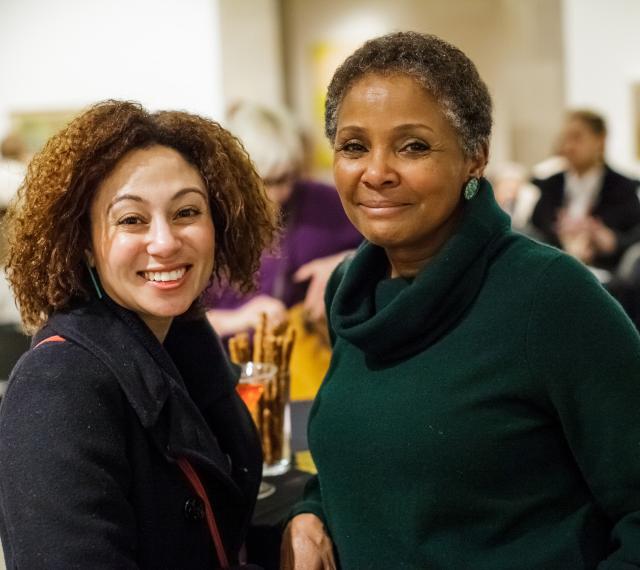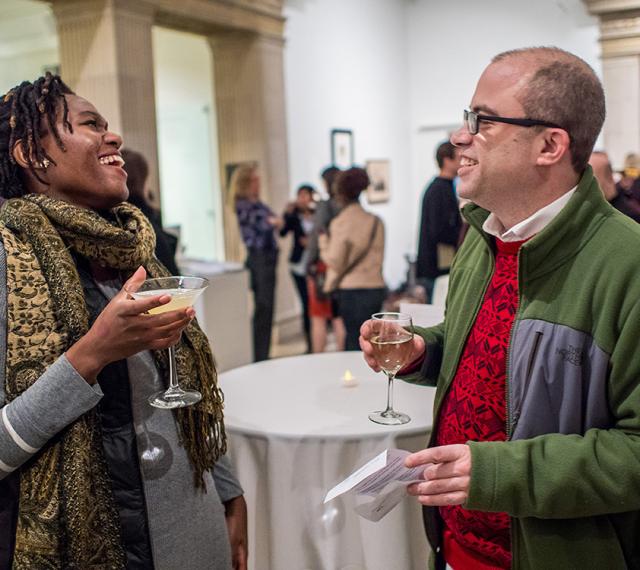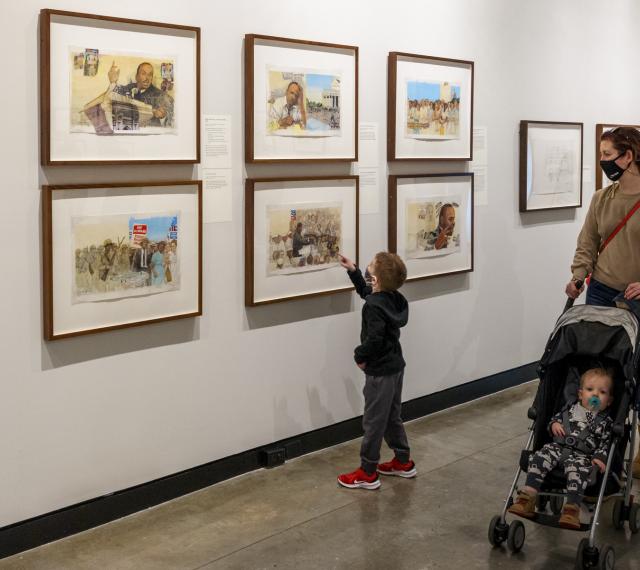Robert Rauschenberg
Chow Bags Portfolio
Written by Paul Schmitz, docent
Robert Rauschenberg’s Chow Bags portfolio (1977) consists of six screen prints with graphite and plastic thread, each featuring a different domesticated animal. The prints are based on paper collages Rauschenberg created from actual bags of animal feed manufactured by Ralston Purina (now Purina Mills), a company best known for its Dog Chow and Cat Chow brands. The packaging for the less common feeds featured in Mink Chow, Goat Chow, Monkey Chow, Hog Chow, Rabbit Chow, and Calf Startena (based on a bag for a livestock feed supplemented with nutrients for early growth) shares the distinctive red-and-white checkered pattern made famous by Purina’s more familiar products. By incorporating this pattern and other prominent design elements of the bags, Rauschenberg’s Chow Bags call attention to the simultaneous familiarity and strangeness of Purina’s graphic identity.
Although the artist selectively cut and partially flattened the paper feed bags to create his collages, he retained their rectangular shape and allowed this form to dictate the overall configuration of each print. The bold, graphic renderings of the animals at the center of these works are surrounded by various arrangements of fainter transfer images such as flowers and leaves, cars stuck in traffic, Coca-Cola bottles, and a woman’s glossy, manicured finger. The resulting compositions present the animals gazing out as in traditional portraiture, playfully framed by colorful graphics and strong geometric shapes.
Photographs of the finished collages were used as the basis for the screen prints. After the silkscreen process, additional collage elements were applied to each print, including small pieces of fabric and plastic stitching that mimics the pull-strings used to open feed bags. The Chow Bags series was printed by Styria Studio in New York, and issued in an edition of 10.
“You can't make either life or art, you have to work in the hole in between, which is undefined. That's what makes the adventure of painting.”
Robert Rauschenberg
Robert Rauschenberg was born Milton Ernest Rauschenberg in 1925 in Port Arthur, TX, the child of a fundamentalist Christian couple. In his youth he planned on becoming a preacher but abandoned that when he discovered his church frowned on dancing. His father worked for the utility company, his mom pinched pennies so much she made all the kids’ clothes, sometimes from scrap fabric. Rauschenberg was embarrassed by this, and there’s been speculation that wearing scraps had an influence on his later art. He asked for a store-bought shirt for his high school graduation.
In 1943, Rauschenberg went on to study pharmacology but was expelled when he refused to dissect a frog. He was immediately drafted, but refusing to bear arms, was assigned to the Medical Corps. He saw his first oil paintings when he went to the Huntington Art Gallery while assigned to a hospital in San Diego. After the war, he used the GI Bill to attend Kansas State University. He celebrated his new life with a new name: Bob.
The next year he went to Paris to study at the Academie Julien. While there he met a fellow student, Susan Weil, whom he later married. When they returned to the US, Rauschenberg followed Susan to Black Mountain College to study under Josef Albers. He admired Albers but was harshly critiqued by him. Rauschenberg did learn fundamental lessons from Albers, though. Albers firmly believed in structure, a grid, upon which to build a painting. Albers taught a course on materials, in which he studied line, color, and textures of everyday materials.
Weil and Rauschenberg split their time between Black Mountain College and New York City, where he studied at the Art Students League. There he met Cy Twombly, later one of the first artists making Conceptual Art. When, after a summer at Black Mountain, Rauschenberg returned to NYC, he was returning to live with Twombly, not Weil. She filed for divorce in 1952. Rauschenberg and Twombly went to travel and study in Europe and North Africa. It was at this time Rauschenberg made his first assemblages.
During his time Rauschenberg also met John Cage and Merce Cunningham who were teaching at Black Mountain. He would collaborate with both for decades. In 1953, he had his first one man show at Betty Parsons Gallery, showing his White Paintings. He also met Jasper Johns, and the two became romantically involved. Rauschenberg moved into the same loft building as Johns and over the next eight years the two challenged the supremacy of the Action Painters. Their work was often called Neo-Dada. Their fundamental principals were that art should involve as well as reflect their lives and that nothing was out of bounds. Everyday objects were used as art materials, paintings could come off the wall, performance was a legitimate medium. It was also fundamental to the beginnings of Pop Art, a celebration of common objects and experiences and a concentration on the Now. The Abstract Expressionists were committed to making a timeless art.
Johns and Rauschenberg eventually split up when Rauschenberg couldn’t deal with Johns being rocketed to the top of the art world while he plodded along.
Rauschenberg was making it, too, but not as dramatically. He had a retrospective at the Jewish Museum in 1963, showing his “combines,” and well-received shows at Whitechapel in London and the Venice Biennale. The following year, Rauschenberg received the First Prize for painting at the Biennale, the first American to receive the honor. Over the next decade, his work became more involved in politics and contemporary events, incorporating NASA imagery and photo transfers of the Kennedys, the moon landing and urban scenes. His wide use of appropriation was very influential. He was sued by a photographer in the early 1970s for appropriating two photos without permission. After that, Rauschenberg used only images he had taken himself.
In 1970, Rauschenberg bought a large piece of land and moved to Captiva Island off the coast of Fort Myers, Florida. He built a very large and equipped studio there, including a state-of-the-art printmaking facility. He traveled extensively, working collaboratively with artists world-wide. He also signed himself into the Betty Ford Clinic to deal with his alcoholism which was becoming life-threatening.
In 1990, the Whitney gave Rauschenberg a retrospective, filling the museum. He continued to work despite serious medical problems, including a badly broken hip and a stroke in 2002 that paralyzed his right side. With the assistance of Darryl Pottorf, his companion for 30 years, he learned to work with his left hand. He worked until his death in 2008.
Rauschenberg’s artwork was deeply influenced by earlier artists—Marcel Duchamp, Kurt Schwitters and Joseph Cornell, and many of the Dada artists. He also gained a great deal from his contemporaries—John Cage and Merce Cunningham, Cy Twombly and Jasper Johns. And his work has had a profound effect on artists who followed—Andy Warhol and Roy Lichtenstein, Claes Oldenberg and Cindy Sherman. And me.
Robert Rauschenberg (1925-2008)
Rabbit Chow, 1977
Photo serigraph and string
Ed. 95/100
48 1/8 x 36 3/8 in.
Gift of Mr. and Mrs. Murray Cohen
1978.215.5




